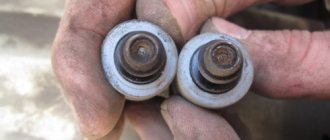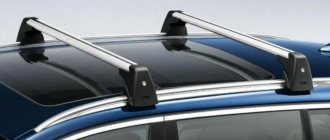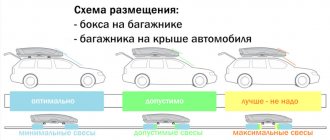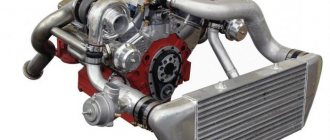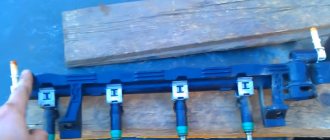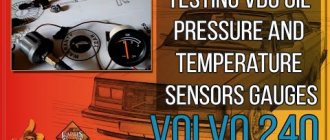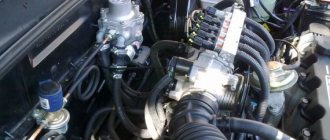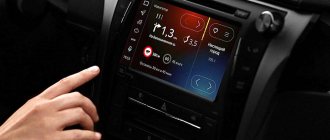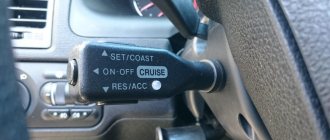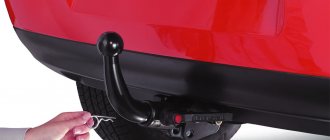Where are the injectors located in the car?
Many car enthusiasts, hearing from service station technicians about the need to flush or replace injectors, do not understand what they are and where they are located. All modern gasoline and diesel internal combustion engines are equipped with a fuel injection system. The injector, like a pump for delivering a powerful but thin stream of fuel, is an integral part of this injection system. In this article we will tell you where the injectors are located in the car and how they work.
In essence, a modern injector is a valve based on a program-controlled electromagnet. It includes the following structural elements:
- rubber gasket;
- filter;
- connector;
- moving core induction coil controlled by ECU;
- core return spring;
- input manifold;
- spray needle;
- nozzle.
The injectors are located on the cylinder block head. How many there are depends on the total number of cylinders, since each requires one. The vast majority of passenger cars have 4 of them.
Similar articles
- Automotive oil pump: device, principle of operation and types
- Car clutch - operating principle and design
- Automotive snow chains: history, installation, application
- EGR valve - what is it and what is it for?
As for the layout, in most passenger cars the injectors are lined up in one row and mounted on a hollow metal tube through which fuel flows into them.
The easiest way to find out whether there are injectors in a particular engine and where they are located is to read the technical data sheet of the vehicle.
Before injectors began to be used on injection engines in conjunction with a control unit, they had a slightly different device. Instead of an induction coil with a movable core, they had a high-pressure valve, which was activated after the fuel was pumped by the fuel pump when a certain pressure was reached. Similar devices are still used on some models of diesel engines.
Types of fuel injectors and their design
Depending on the method of controlling the fuel supply, injectors are divided into several types:
Mechanical models
This type is common on diesel engines. It operates as a result of fuel pressure acting on the locking mechanism. In the process of increasing the indicators, the needle is directed upward, provoking injection. After the pressure drops, it takes the previous position.
Mechanical models are common in diesel engines.
Mechanical injectors are less efficient than other types and are therefore rarely used in modern vehicles. At the same time, the parts have a simple and reliable design, which ensures a long service life.
Electromagnetic injectors
This type of injector is found on gasoline cars, including models with direct fuel supply. Depending on the functions they perform, injectors can be classified as starting or working. The second type carries out point or individual injection.
The design of the part includes the following components:
- Frame.
- Compartment for connection to the electrical circuit.
- Igloo.
- Seals.
- Nozzle.
- Valve excitation winding.
- Filter mesh and other elements.
Electromagnetic injectors are found on gasoline cars.
At the right moment, the motor unit sends voltage to the winding, contributing to the appearance of an electromagnetic field that affects the armature with the needle. At this time, the compression force of the spring decreases, the armature is retracted, and the needle rises, opening the injector nozzle. Then the nozzle control valve is activated and fuel is supplied at peak pressure. After the power supply to the winding is stopped, the spring returns the needle to its initial position.
Electrohydraulic devices
Electrohydraulic type models are found on diesel units. They can be installed on a standard fuel injection pump and a Common Rail complex, the peculiarity of which is the supply of fuel to the combustion chamber under high pressure.
The device contains the following parts:
- Nozzle through which fuel is directly supplied.
- Spring used to transmit force to the opening valve.
- Control chamber , where the piston is located under fuel pressure.
- Drain throttle.
- Electromagnetic element armature.
- Excitation winding, which creates an electromagnetic field .
- Fuel injection port.
Electrohydraulic devices are installed on diesel units.
During the cycle, the valve is in a closed state. The fuel in the system acts on the control chamber piston, and the injector needle is pressed tightly against the seat. The motor control unit sends voltage to the winding and the drain choke reopens. As a result, fuel is transferred to the main line.
The inlet mechanism prevents instant equalization of pressure in the chamber and at the inlet. Therefore, for some time, the force that acts on the piston decreases, but the pressure on the needle remains. Due to the difference in indicators, the needle rises and regulates fuel injection.
Piezoelectric parts
The device is found only on diesel engines and is considered the most advanced type of injector. This type facilitates instantaneous operation of the injection system, selection of the exact dosage and repeated supply of fuel. Such injectors are common in diesel units with Common Rail technology.
To assemble piezoelectric mechanisms, use:
- Igloo.
- Throttle block.
- Valve springs and pistons.
- Drain line.
- Filter.
- Discharge line and other parts.
Piezoelectric parts are considered the most advanced type of injectors.
The injector operates on the principle of changing the length of the piezoelectric element when voltage is applied. In the basic position the needle is on the seat. When the electronic control unit sends a signal to the piezo element, the latter influences the piston. The switch valve is actuated and the fuel goes to drain.
What are injectors for in a car?
Now, a little more specific data about the real benefits of injectors and their role in ensuring the operation of the car. First of all, this device is the main connecting element between the engine and the fuel pump. Their purpose can be described as follows:
- ensure the correct dosage of fuel supplied to the engine;
- ensure the correct flow (angle, pressure, quantity) of the mixture, as well as its preparation;
- intermediary actions between the general injection formation system and the combustion chamber, where the valves with pistons are located;
- maintaining the correct release rate curve.
The design features of the injectors directly depend on the specific modification and control method (mixture supply). But piezoelectric injectors are considered the most effective, rational and practical today. Their advantage is the possibility of multiple injections in one cycle, as well as the speed of response.
Nozzle control
As mentioned above, the injectors are controlled using the vehicle's electronic control unit (ECU). Based on information received from numerous sensors, its processor makes decisions about which pulses to send to the injector. The engine speed and operating mode depend on this.
So, the input data for the controller is:
- crankshaft position and speed;
- mass amount of air consumed by the engine;
- coolant temperature;
- throttle position;
- oxygen content in exhaust gases (if there is a feedback system);
- presence of detonation in the engine;
- voltage in the electrical circuit of the car;
- machine speed;
- camshaft position;
- air conditioning operation;
- incoming air temperature;
- driving on uneven roads (if there is a rough road sensor).
The program embedded in the ECU controller allows you to select the optimal engine operating mode in order to save fuel, select the nominal engine operating mode and ensure comfortable operation of the vehicle.
Conclusion
Despite the simplicity of their design, fuel injectors, if not properly cared for, can cause a lot of trouble for the car owner. So, if they become clogged, the car will lose its dynamic characteristics, excess fuel consumption will occur, and there will be a large amount of burning in the exhaust gases. Therefore, we recommend that you monitor the condition of your car’s engine fuel injectors and clean them periodically. Remember that problems with these essentially trivial and cheap parts can result in problems with more expensive components of your car.
Are there any differences between fuel injectors for diesel and gasoline engines?
Injectors for diesel engines have a smaller cross-section, and their operating principle is much more complex. To determine a breakdown, special knowledge is required. Such engines require increased tightness of the fuel system.
For such power plants, electromagnetic and piezoelectric models are used.
Gasoline engines have single- and multi-point injectors. The former regulate the fuel supply and are installed in front of the damper, while the latter include several injectors mounted in front of the pipelines. The device supplies gasoline to the combustion chamber, but has a non-separable design, so it cannot be repaired. The cost of components for gasoline engines is much lower than for diesel engines.
What is a nozzle
An injector is an integral part of the engine fuel system that supplies fuel to the cylinders at a certain time in a certain quantity. Fuel injectors are used in diesel, injection, and mono-injection power units. Today, there are several types of nozzles that are fundamentally different from each other.
The difference between high-speed injectors and regular injectors
When choosing an HBO gas injector, you should pay attention to the speed of operation of these devices. Because injectors differ in the speed of closing and opening of the rod. They also differ in electric valve coil resistance, stem types, appearance and connector. Namely, it will depend on the engine and its volume which injector is needed for the car: high-speed or regular.
It is worth noting that the power characteristics of LPG, as well as propane or methane savings, will depend on the response speed of the LPG injectors and on how accurate the gas injection into the engine system will be. For example, on a car that has a powerful engine, high-speed injectors (for example, AEB or Hana) should be installed. And if the engine volume is 1.5 liters, then install regular injectors (for example, RAIL).
For high-speed injectors, the coil resistance is 1.9 Ohm, the injector response speed is 2ms, the maximum pressure is 4.5 bar.
At the same time, for conventional injectors, the coil resistance is 3 Ohms, productivity is 15-35 hp/cyl., maximum pressure is 3.0 bar, operating pressure is from 0.5 bar to 2.0 bar.
Cleaning the injectors
Due to the presence of harmful impurities in the fuel, carbon deposits may accumulate on the injectors. The injector washing operation involves the process of washing away contaminants from the injector system. You can wash the injectors with a special liquid (special additive). In this case, the injectors do not even need to be removed from the engine. This additive is added to the fuel, and the engine is allowed to run on this mixture for 2-3 thousand kilometers. You can also wash the injectors faster without removing them from the engine. For this, a special installation is used, which is connected to the engine instead of the fuel pump. A special flushing fuel, solvent, is supplied to the injectors. This washing takes about 15 minutes.
You can also clean the injectors from carbon deposits using an ultrasonic stand.
To do this, the injectors are removed from the engine fuel system. [su_youtube url=”https://www.youtube.com/watch?v=bMVw18aXQys”]
Why does it protect you from bullies?
You probably guessed it yourself.
- Excessive temperature is removed from the piston.
- This means that there is no excessive thermal expansion of the piston and rings (compression and oil scraper)
- Better lubrication of the cylinder (after all, oil is sprayed not only on the piston bottom, but also on the walls). And this means better glide, it also gives resource
Now let's watch the video version of the article.
This is where I end my materials, I think they were useful to you. Write comments, subscribe to the YOUTUBE channel, sincerely yours, AUTOBLOGGER
(
14 votes, average: 4.57 out of 5)
Similar news
Is it necessary to warm up the engine? Before the trip? Let's analyze winter and summer.
Oil leaking from under the valve cover. Why - let's look at the main ones.
Why is a diesel car more expensive than a gasoline car? Sub-dr.
Add a comment Cancel reply
Comments
TOP articles for the month
The holidays are coming, which means most of our country will be drinking alcohol. Easy: -…
The vehicle battery voltage, as well as its capacity, are the most important indicators of this automotive unit,...
I am often asked about car emissions. Often, newbies, and even experienced drivers, don’t like…
Diesel injector malfunctions
Like almost all elements of fuel equipment, injectors can suffer from many influences - both external and internal. Fortunately, all faults are easy to notice yourself, without resorting to professional diagnostics. The latter should only be contacted when the car needs to be left at a service center.
and begin preparing to purchase new parts or repair existing ones. Malfunctions of diesel injectors can be expressed as follows:
- High temperature, as well as knocking of exhaust gases;
- Dips, less often jerks of the working engine with increasing loads;
- Unstable operation of the internal combustion engine at low speeds;
- Dark and toxic exhaust;
- Significant reduction in engine power.
The above is also true for gasoline injectors. A clear sign of a malfunction of the fuel equipment is a drop in power and strange operation of the engine when the speed increases. In the case of diesel injectors, operational faults can be divided into 2 categories:
- Faulty operation of the injectors due to improper installation or assembly of the equipment. When installing new injectors, the technician could have caused misalignment of parts, pinching of the needle, and blockage of the fuel channels;
- Malfunctions caused by dirty injectors. The number one enemy of diesel engines is diesel fuel itself. Firstly, low-quality fuel contaminates the fuel system over time. Secondly, the same fuel can cause overheating. As a result: leakage, needle melting, fuel filter failure.
Less commonly, the injector sins with the following: incorrect pressure adjustment (the spring is worn out), needle sticking (the problem can be solved by cleaning the part or replacing it). As a rule, a diesel injector can easily travel the 100-150 thousand kilometers declared by the manufacturer. With proper operation and filling with high-quality fuel, the resource increases by another 30-50 thousand kilometers.
Location
Many people do not know about injectors in a car. Where are these elements located? Their location depends on the type of injection:
- With central fuel injection, one or a pair of injectors are located inside the intake manifold, near the throttle valve. So, the nozzle is a replacement for an already outdated device - a carburetor.
- With distributed fuel injection, each cylinder has its own injectors installed in the car. Where are they in this case? At the base of the intake pipeline, into which fuel is injected by the nozzle.
- With direct fuel injection, they are located in the upper region of the cylinder walls. They inject fuel into the combustion chamber itself.
How to clean injectors.
One of the simplest and most common methods is to add a cleaning additive to the fuel through the gas tank, which will dissolve all deposits during direct operation of the system. Many experts recommend this cleaning, but only as a preventative measure, and not in case of total contamination, since it will not be able to remove the heaviest fractions. Moreover, if the system becomes very clogged during long-term use, then this procedure can only cause harm to the vehicle. As a result, the injectors can become clogged even more.
This is directly related to the fact that all deposits from the fuel tank will go directly to the fuel pump, as a result of which this device will simply fail. Another method will require special special-purpose equipment and some operating skills. Using special adapter fittings, the device required for flushing will be connected to the injector. It is due to the fitting that the fuel tank, filter and fuel pump will be removed from circulation. Instead of fuel, a special flushing liquid will flow directly into the injector from a prepared cylinder, which is connected through tubes.
The engine will run for about half an hour with this cleaner. During this period, all contaminants will liquefy and pass through the injectors, after which they will simply burn in the engine cylinders. However, even this method cannot guarantee a 100% panacea for dirty injectors. Even after this type of cleaning, some particles of the flushing fluid will remain in the oil system itself and the injector. After this, you will need to drive several tens of kilometers in forced engine operation, and then change the oil and oil filter. It is quite obvious that this method will require special time and financial costs. It is important to note that these two methods will be most relevant for those cases when the vehicle has low mileage, and dismantling the injectors is quite difficult, since the design features of their location are not the best and most convenient.
Types of nozzles
The injector is an electromagnetic valve controlled by a special program in the unit that controls the car engine. It is thanks to the nozzle that fuel is supplied to the cylinders in doses. If they talk about an injector, then they mean a system of controlled nozzles. There are several types of injectors that are designed: for distributed fuel injection; central injection; direct injection.
PARAMETERS, PROPERTIES, VALUES
The fuel system of most vegetable Honda Civics consists of a fuel tank (45 l), a fuel pump, connection lines, a fuel filter, a fuel rail, the injectors themselves, and a “return” system with a valve. Fuel from the gas tank is supplied to the fuel pumps through the fuel wire to the fuel rail (through the filter). An NR-1 pressure regulator (Fuel Pressure Regulator - FPR) is installed on the fuel rail; in most cases it is sufficient; it was installed on most engines, but with a different fastening system. In general, fuel enters the fuel rail at a pressure of about 3 Bar (3 atmospheres, 3000 mBar), if the pressure is higher, the FPR NR-1 valve throws the excess into the “return”, and from the “return” the fuel enters the gas tank. The value of the injectors is like 190, 240 (180, 235), etc. shown in cubic centimeters.
The full designation looks like this: 240 [email protected] , that is, the nozzle releases 240 cubic meters of liquid in 1 minute at a pressure of 3 bar (this is the normal pressure of most pumps). If you previously had 190 injectors, and you want to install 240 simply by replacing them, then you need to ask yourself a question. For what? 190 injectors do not operate at 100% even at full engine load, that is, there is a reserve of 15%. Yes, I agree that if you increased the volume or installed an air blower (turbine), then replacing the injectors would be necessary.
And so you will get extra expenses. The computer program says that, let’s say at 450 mBar (45 kPa), injector 190 should work for only 100 ms, replacing it with 240, without changing the opening time in the fuel map, you will get an excessively rich mixture. This is the same as if you were asked to open a large and small tap with water at the same time, for the same time, where do you think the flow rate will be greater? Consider replacing injectors carefully. Unless you have a dyno and/or tuning demon like a Moates or Hondata I wouldn't recommend changing the injectors. An important parameter of injectors is resistance; it is necessary that the resistance of new and old injectors be the same.
For this purpose, you can buy a ResistorBox ($30-100) in a fashionable way. And according to normal, powerful ceramic resistances ($0.5-5). If you do not balance the resistance with the brain, then there is a possibility that the brain outputs to the injectors will burn out. Low resistance injectors 2.5-3 Ohm, High resistance 12 Ohm. The danger lies in low-resistance ones; of course they are high-performance, but additional control is needed. At 50% load, 2.5 Ohm (low resistance) injector at 7 minutes, when operating at 6000 engine speeds, the brain begins to burn, the temperature of the keys (transistors) is 170-200 degrees Celsius, in the normal state it is 60 degrees. Typically, transistors like STA413A and STA464C are used, operating up to a maximum of 150 degrees, then either the parameters go away or the case breaks.
Operating principle of the injector
The principle of operation of an injector in cars can be divided into two parts - the mechanical component and the electronic component.
- fuel tank;
- electric fuel pump;
- gasoline purification filter;
- high pressure fuel lines;
- fuel rail;
- nozzles;
- throttle assembly;
- air filter.
Of course, this is not a complete list of components. The system may include additional elements that perform certain functions, it all depends on the design of the power unit and the power system. But these elements are basic for any engine with a distributed injection injector.
The tank is a container for gasoline where it is stored and supplied to the system. The electric fuel pump is located in the tank, that is, fuel is taken directly by it, and this element ensures the supply of fuel under pressure.
Next, a fuel filter is installed in the system, which cleans gasoline from foreign impurities. Since gasoline is under pressure, it moves through a high-pressure fuel line.
To prevent excess pressure, the system includes a pressure regulator. From the filter, through the fuel lines, gasoline moves to the fuel rail connected to all the injectors. The injectors themselves are installed in the intake manifold, not far from the cylinder valve assemblies.
A modern injector is electromagnetic and is based on a solenoid. When an electrical pulse is supplied from the ECU, a magnetic field is formed in the winding, affecting the core, causing it to move, overcoming the force of the spring, and opening the feed channel. And since gasoline is supplied to the nozzle under pressure, gasoline enters the manifold through the opened channel and atomizer.
On the other hand, air is sucked into the system through the air filter. A throttle assembly with a damper is installed in the pipe through which the air moves. It is this valve that the driver acts upon by pressing the accelerator pedal. At the same time, it simply regulates the amount of air supplied to the cylinders, but the driver has no influence at all on the fuel dosage.
For its operation, the ECU uses sensor readings:
- A lambda probe, installed in the exhaust system of a car, detects the remaining unburned air in the exhaust gases;
- The mass air flow sensor (MAF), located in the air filter element housing, determines the amount of air passing through the throttle assembly when it is sucked in by the cylinders;
- The throttle position sensor (TPS), installed in the throttle assembly, sends a signal about the position of the accelerator pedal;
- The power unit temperature sensor, located near the thermostat, regulates the mixture composition depending on the engine temperature;
- The crankshaft position sensor (CPS), installed near the crankshaft pulley;
- Knock sensor located on the cylinder block;
- Speed sensor, installed on the gearbox;
- The phase sensor, designed to determine the angular position of the camshaft, is installed in the cylinder head.
The electric fuel pump fills the entire system with fuel. The controller receives readings from all sensors and compares them with the data stored in the memory unit. If the readings do not match, it adjusts the operation of the engine power system so as to achieve maximum agreement between the received data and those stored in the memory unit.
Fuel injector diagnostics
The specifics of injector diagnostics are determined by the type of part. In this case, diagnostics can be performed both in the service center and in the garage.
Power check
To assess the power supply you will need to do the following:
- Remove the power connector for the injector of the first cylinder.
- Connect a multimeter with settings for estimating DC voltage within 0-20 V.
- Start the car and analyze the measurement results. When in good condition, the injector gives short pulses.
- If there is no voltage coming to the power supply, turn off the car and check the wiring or find the defect during a visual inspection.
- Connect the injector of the first cylinder and repeat the checking procedure with the 2-4th elements.
To assess the power supply, you will need to remove the injector power connector.
Change resistance
First you need to clarify the injector model that is used on your vehicle. Next, you should determine the resistance of the coils inside the part.
After turning off the engine, you need to remove the power connectors, connect the multimeter and start it in the 0-200 Ohm measurement mode. It is important to analyze the resistance of each part. It must comply with the parameters stated in the technical specifications.
Diagnostics on the ramp
For diagnostics, you need to remove the fuel rail with fixed injectors. Next, you should connect the contacts to the ramp and injectors (if they were disconnected). The ramp is placed under the hood in such a way that it is possible to install a container with a scale under each part.
After this, you need to connect the fuel supply pipes and make sure they are securely fixed.
Clogged injectors
The next step is to turn on the ignition and crank the engine with the starter. It is better to carry out such actions together with a colleague.
While the second person is turning the engine, it is important to ensure that all injectors are working properly. Fuel injection must remain identical on all elements.
The final stage comes down to turning off the ignition and assessing the volume of fuel in the containers.
Testing at the stand
Auto repair shops have installed stands for diagnosing and restoring injectors. The test method for such a surface involves disassembling the ramp and vehicle injectors. The stand allows you to implement complex diagnostics, check the efficiency of fuel injection and determine electrical resistance. Some craftsmen build stands at home.
Structure
As already mentioned, the main task of the injector is to supply the right amount of gasoline mixture into the combustion chamber at the right pressure at the right time. Please note that only a gasoline engine needs a gasoline mixture, while a diesel engine also needs a diesel mixture. Before entering the engine combustion chamber, gasoline and air are mixed in a certain amount. Once this mixture is produced, it enters the combustion chamber.
In order to send the correct amount of fuel mixture under pressure into the engine cylinders, a special valve is provided, which, when opened, collects fuel and squeezes this mixture into the cylinders.
There are different types of injectors; they are distinguished only by the principle of operation and the valve drive. Today there are three types of injectors. The main type of them is an injector with a solenoid valve. This type is most common on gasoline engines because the design of this device and the principle of operation are so simple that they only need to be washed from time to time.
The principle of operation is based on the fact that a special winding is located in the nozzle body, which creates a vacuum at a certain moment according to a signal from the electronic unit, which knows how much gasoline needs to be sent into the combustion chamber.
During this tension, the needle rises from its seat and directs the required amount of fuel, using high pressure, into the combustion chamber. The pressure in the fuel rail is kept at a constant level. If the engine needs more fuel, the pump increases the pressure automatically.
The second type is electrohydraulic nozzles. This type is most common among diesel engines. This device starts working based on a signal from the electronic unit, which knows how much gasoline the engine requires. Here, fuel enters the combustion chamber due to changes in pressure on the pistons.
There is another type of injector, but it is found only on diesel engines with a Common Rail fuel system installed. Such nozzles have advantages over other types in response speed and pressure quality. Thanks to this, fuel can enter the combustion chambers at a certain pressure during the entire cycle, which has a positive effect on engine power. The operating principle here is based on hydraulics, as in the second type.
Operating principle of injectors
Fuel is supplied to each injector from the fuel rail at a certain pressure. The injector solenoid receives electrical impulses from the engine control unit. They operate a special needle valve, which opens and closes the channel in the nozzle. The longer the electrical pulse is received, the longer the needle valve is open, and the more fuel is supplied. The opening time of the needle valve is controlled by the engine control unit. In addition, types of nozzles allow you to create different shapes and directions of the sprayed fuel, which significantly affects the process of mixture formation.
How to check an injector nozzle for serviceability
Problems with injectors occur both on cars powered by diesel fuel and on gasoline-injected cars. An injector is a part responsible for injecting fuel under a certain pressure. It is useful to know how to check the injector nozzle if starting difficulties occur.
HYDROMECHANICAL INJECTORS
Hydromechanical nozzles (HM nozzles) are of open and closed types. The first type of GM injectors are jet injectors and are not used in modern gasoline injection systems. GM injectors of a closed type are intended for use in mechanical systems of continuous fuel injection distributed among the cylinders on gasoline internal combustion engines. These injectors are not electrically controlled. They open under the pressure of gasoline and close with a return spring. The gasoline pressure at which a closed injector opens is called the initial operating pressure (IOP) of the injector and is designated as Rfn. Closed-type GM injectors are installed in the pre-valve areas of the intake manifold for each cylinder separately.
In design, closed injectors can differ in the design of the shut-off valve and the method of mounting in the cast housing of the intake manifold. Based on the type of shut-off device, closed nozzles are divided into nozzles with a spherical, disk and pin valve; according to the method of fastening - plug-in and threaded.
Closed GM injectors do not take part in fuel dosing. Their main function is to spray gasoline onto the hot engine intake valves. In this case, the atomized gasoline particles turn into a vapor state, and the intake valve cools. To avoid contact of the gasoline stream with the walls of the pre-valve zone of the intake manifold, gasoline is sprayed with an opening angle of no more than 35 degrees, and the nozzle is installed in relation to the valve according to a strictly specified geometry.
Fuel dosing in a mechanical injection system is carried out by changing the gasoline pressure at the constantly open spray nozzle of the injector. In this case, the pressure pressure is formed by pressure outside the nozzle - in the differential valve of the metering distributor of the mechanical injection system.
In order for the closed-type injector valve to be in the “open” state, the gasoline pressure in the valve cavity 6 must always be slightly higher than the force Pp of the return spring 10 (Pfn > P„).
This is achieved by setting a sufficiently high (at least 6 bar) operating pressure Ps (OPS) in the system (in the fuel supply line to the metering distributor) and maintaining the Ps Ps at a constant level.
THE MAIN PARAMETERS OF A CLOSED NOZZLE ARE FIVE INDICATORS.
1. Initial operating pressure Рфн (НРП) of the nozzle immediately after its assembly at the manufacturer (opening pressure of a new nozzle). NRP for closed nozzles of various modifications lies in the range of 2.7...5.2 kg/cm2. For new injectors from the same size range, the NSD may differ by no more than ±20%. When selecting a set of injectors for an engine, the difference in NWP should not exceed ±4%. The injectors are sold for sale (as spare parts) with the same NSD in the packaging. Replacing injectors with an incomplete set may cause problems with normal engine operation.
Useful: How often should you replace car wiper blades?
2. Minimum operating pressure Рфт|„ (MWP) of the injector after its running-in on the engine (after 5000 km). This pressure becomes less than the NWP of the new nozzle by 15...20% and stabilizes (over 5 years of normal operation it changes by no more than 5%).
3. Working pressure of the RF injector after its running-in. This is the pressure in the internal cavity of the injector that changes during engine operation from the minimum operating pressure Рф min (MWP) to the maximum operating pressure Ps max (РПС) in the mechanical injection system.
4. Injector cut-off pressure P0 (DOT). This pressure below which the nozzle is securely closed is sometimes called drain pressure). The cut-off pressure is always less than Рф min by 1.0...1.5 kg/cm2, but slightly higher than the residual pressure Increase in the injection system immediately after turning off the engine.
5. Performance of Pf injectors. This is the amount of gasoline that is sprayed through a constantly open nozzle per unit of time at a certain operating pressure Рф in the nozzle cavity. Typically, Pf of a closed nozzle is set for two extreme values of operating pressure: Pf min and Ps max. These two values correspond to two engine operating modes: Рф m,n - idling, Ps m8K - full load. The productivity of Pf is set in cm3/min or in g/s. For example, for closed injectors of a 5-cylinder internal combustion engine of an AUDI-1O0 car (2.2 l, 140 l/s), the performance indicators are respectively 30 and 90 cm3/min (when working in the K-Jetronic system).
Failure closed-type injectors cannot be repaired, but, like any others, they can be “washed” as part of the injection system while the engine is running.
ELECTROMAGNETIC INJECTORS
Electromagnetic injectors are used in modern gasoline injection systems as valve operating and starting injectors (for electronically controlled cylinder injection systems), as well as central injection nozzles (in power systems with single injection). The central nozzle is the most common design for gasoline injection systems of the “Mono” group.
Modern EM injectors are capable of reliably operating with a duty cycle* S = 0.5 and at the same time stably (controllably) maintaining the open state for 2...2.5 ms. The spread of this parameter in a specific size range of injectors is no more than ±5%. This speed of operation of the EM injector corresponds to the frequency of the reciprocating movement of the movable rod of the injector electromagnet of 200...250 s-1. This is the limit of what is possible for this type of electrically controlled injectors.
When using EM injectors as valve injectors, the operating pressure Ps in the injection system can be reduced from 6.5 bar (in mechanical systems) to 4.8...5 bar, which increases the reliability of the electric fuel pump and reduces the likelihood of fuel leaks in the gasket sealing joints. gistrals.
With electronic control of injectors, the accuracy of dosing of injected gasoline is significantly increased. This becomes possible because the pressure inside the EM injector is maintained constant, and the amount of injected fuel is determined only by the time the injector is open.
THE MAIN PARAMETERS OF THE EM NOZZLE ARE:
1. Constant operating pressure in the nozzle cavity (COP), equal to the operating pressure Ps of the system, expressed in bar.
2. Nozzle performance (throughput capacity in the OPEN CONDITION - IN CM3/MIN or in g/s at a given RDS Ps).
3. Minimum voltage for reliable operation of the injector (constant voltage in volts).
4. Minimum time of cyclic fuel supply (minimum reliably controlled time of duration of the injector open state - in ms).
5. Internal ohmic resistance Nf of the injector (resistance of the solenoid coil - in ohms).
A digital code is printed on the injector body, which can be used to determine all of the above parameters in the reference catalog. The trademark or name of the manufacturer is also stamped on the body.
The internal ohmic resistance Nf of the injector should be discussed separately. If the solenoid coil is wound with copper wire, then it is impossible to obtain a value of Нф more than 2...3 Ohms (the requirement to minimize the inductance Ls of the coil is imposed). In this case, to limit the operating current 1ph of the injector, an additional resistor is connected in series with the solenoid coil. A high resistivity winding wire is also used (for the solenoid coil), which eliminates the need to install additional resistors. But in any case, the total average control current of all injection nozzles (or a group of nozzles) on the engine at once should not exceed 3...5 A.
In some cases, “group” control of injectors is used on multi-cylinder engines. This is when the injectors are combined into groups, and each group is controlled from a separate electronic unit. But the most effective is the gasoline injection system, in which each working valve EM injector is controlled independently of the others (sequential synchronized pulse gasoline injection distributed among the cylinders controlled by a multi-channel injection computer).
Useful: CVT operating principle: what it is and how it works
Based on the type of shut-off valve, EM nozzles, like hydromechanical ones, are divided into three types:
— nozzles with a spherical shut-off element profile:
- nozzles with a pin valve (with a cone or needle shut-off rod):
— nozzles with a disc valve (with a flat or poppet shut-off element).
Nozzles with internal electrical resistance of 2.4 Ohms are available: 12.5 Ohms; 16 Ohm. Low resistance is associated with the use of a copper winding wire and with the need to have a small value of inductance L of the solenoid, which directly depends on the number of turns Wc of the solenoid winding.
The low resistance of the injector is increased by an additional resistance of 6...8 Ohms, which reduces the consumed current. The windings of a high-resistance injector are made of wire with a high resistivity (for example, brass), which allows you to have a small L and a large R.
In terms of P injection performance, injectors are selected according to the types and power of the engines on which these injectors are installed. The performance of the injector is determined under the operating pressure of the system, as the amount of kW of gasoline passing through the injector per unit of time t, if it is constantly open.
STARTING ELECTROMAGNETIC INJECTORS
Electromagnetic injectors also include hydraulic starting valves with electromagnetic control, which in their operating principle are not much different from EM injectors. That is why hydraulic starting valves are often called starting injectors.
The main purpose of the starting injector (PS injector) is to work in a mechanical continuous distributed injection system during starting a cold engine. Sometimes a PS injector is used as an afterburner device, like an accelerator pump in a carburetor, or as a device for starting an overheated turbocharged engine. The starting injector is also used in some L group injection systems. In any case, the PS injector operates directly from the vehicle’s electrical system, and is connected indirectly to the electronic engine control system through a special electronic control relay.
There are no high response speed requirements for PS injectors, which greatly simplifies the design of its components. Thus, the mass of the electromagnet armature, which (the armature) is also the locking element of the injector valve, the number of turns of the electromagnet coil, the cross-section of the spray nozzle, the elasticity of the return spring - all this is noticeably increased compared to the working valve EM injector.
Choosing an injector for the engine
To choose the right nozzle, the first thing you should do is decide on the type of part installed on the equipment.
It should be dismantled. To avoid damaging the threaded connection when unscrewing the part, use a mallet (or hammer). As soon as the ring (or socket) wrench turns, continue unscrewing it with light blows of a hammer. After dismantling the nozzle, examine the inscriptions on the edges. To select the appropriate part you will need the following information:
- Manufacturer (for example, Danfoss).
- Fuel consumption.
- Spray angle.
Model OD injectors
If you use a 16th wrench for dismantling, and the nozzle size is set to 0.3 cm, the equipment uses a standard OD nozzle.
It is considered universal and is used in liquid fuel nozzles for oil, fuel oil and diesel fuel. Fuel consumption is indicated in kg/h and, according to the US system, in gallons (gal/h). This indicator also determines the part number. The volume of an American gallon corresponds to 3.785 liters. The designation of the spray angle of the fuel mass is in the usual degrees (⁰), next to the number there is an English letter (for example, S). The letter indicates the cloud (pattern) of the spray variant of this part. The abbreviation will also indicate the date of manufacture of the specific part. For example, 25.X.02 (the injector was released on October 25, 2002).
Thus, the necessary data for selecting a suitable OD injector model may look like this: Danfoss 0.55/60⁰ S. This means that the part was manufactured by Danfoss, has a fuel consumption of 0.55 gallons/hour, and a spray angle of 60⁰. Spray occurs along the cloud (pattern) S.
Injector voltage
Let us dwell in more detail on the question of what voltage is supplied to the engine injectors. First of all, you need to understand that they are controlled using electrical impulses. Moreover, the “+” from the battery is supplied directly to the injector through the fuse, but the “-” is controlled by the ECU. That is, at different times the voltage at the injector is constant. However, if you take a measurement using an oscilloscope (a multimeter in this case may not show anything, since the pulses are very short), then this device will show the average value. It will depend on the frequency with which pulses arrive at the injector.
The graphs shown in the figure will help us answer the question - what voltage is supplied to the injector. The longer the voltage pulses supplied to the injector, the higher the average operating voltage will be (the duration of the pulses for most machines is within 1...15 ms). And long pulses are supplied at high engine operating speeds. Accordingly, the higher these same revolutions, the higher the average operating voltage at the injectors will be. That is, the working 12 V is supplied to the injectors (actually a little less due to a slight voltage drop across the control transistor), but in a pulse.
Some car owners try to open the injector by simply applying current from the battery in order to clean it. It is necessary to understand that voltage cannot be supplied directly from the battery to the injector, since there is a risk that it will fail (its winding will burn out). The pulse is supplied to the device through a transistor switch. It only works for a short time, since the winding in the nozzle heats up quickly and can simply burn out. During engine operation, the opening time is controlled by the ECU, and its natural cooling, albeit insignificant, is carried out by the incoming fuel.
As stated above, car manufacturers use injectors with different operating voltages. Therefore, the ideal solution would be to look at this information in the car’s manual or on the manufacturer’s website. If you cannot find this information, then you need to approach the selection of voltage to open the injector carefully.
In practice, to open the injector, experienced motorists advise using a special stand. However, you can get by with simpler devices. For example, buy a Chinese power supply with an output voltage adjustable within 3...12 V (usually in steps of 1.5 V). The connection diagram must have a button without a stable position (for example, from an apartment bell). To open the injector, you should first apply the smallest voltage, increasing it if the injector does not open.
If you have low-resistance injectors, then you can open them literally for a split second. Injectors with high resistance can be kept open longer - 2...3 seconds.
You can also use a battery from a screwdriver. Having disassembled it, you will see the so-called “banks” - small batteries. Each of them produces a voltage of 1.2 V. By connecting them in series, you can achieve the required voltage to open the injector.

